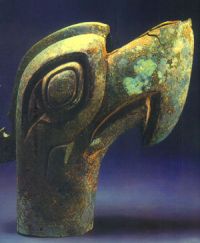Difference between revisions of "CIIC:Today's featured article/September 29, 2009"
From Wiki China org cn
imported>Ciic (Created page with 'thumb|200px|left The site of Sanxingdui, located in the city of Guanghan, 40 km from Chengdu, Sichuan Province, is recognized as one of the most important...') |
imported>Ciic m |
||
| Line 2: | Line 2: | ||
The site of Sanxingdui, located in the city of Guanghan, 40 km from [[Chengdu]], [[Sichuan Province]], is recognized as one of the most important ancient remains in the world for its vast size, lengthy period and enriched cultural contents. | The site of Sanxingdui, located in the city of Guanghan, 40 km from [[Chengdu]], [[Sichuan Province]], is recognized as one of the most important ancient remains in the world for its vast size, lengthy period and enriched cultural contents. | ||
| − | The first Sanxingdui relics were discovered by a farmer in 1929 and excavation has continued ever since. During this period, generations of archaeologists have worked on the discovery and research of the Sanxingdui culture. In 1986, two major sacrificial pits were found and they aroused widespread academic attention around the world. | + | The first Sanxingdui relics were discovered by a farmer in 1929 and excavation has continued ever since. During this period, generations of archaeologists have worked on the discovery and research of the Sanxingdui culture. In 1986, two major sacrificial pits were found and they aroused widespread academic attention around the world. ('''[[Sanxingdui|More ... ]]''') |
Revision as of 05:49, 23 September 2009
The site of Sanxingdui, located in the city of Guanghan, 40 km from Chengdu, Sichuan Province, is recognized as one of the most important ancient remains in the world for its vast size, lengthy period and enriched cultural contents.
The first Sanxingdui relics were discovered by a farmer in 1929 and excavation has continued ever since. During this period, generations of archaeologists have worked on the discovery and research of the Sanxingdui culture. In 1986, two major sacrificial pits were found and they aroused widespread academic attention around the world. (More ... )
